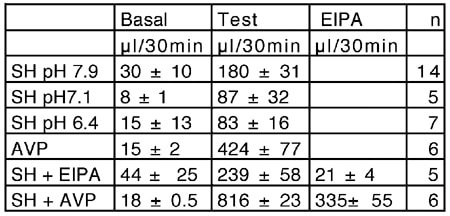Exposure of the serosal face of anuran urinary bladder to hyperosmotic solutions (SH), results in a reversible increase in water flux (Jw) which is similar in time course and magnitude to that elicited by arginine vasopressin (AVP) (Bentley, 1964). The hydro-osmotic response to serosal hypertonicity and AVP in combination is additive. Unlike the response to AVP the response to SH is absent in nominally chloride-free solutions (Hanna-Mitchell & Gebruers, 2001).
To examine the pH dependence of Jw, male Rana temporaria bladders were studied in a series of experiments using a modification of the gravimetric method of Bentley (1958). Frogs were stunned, decerebrated and pithed, and bladders were dissected out. These were filled with hypotonic Ringer solution, R/2, (120 mosmol (kg H2O)-1) and immersed in a bath of either isotonic R or hypertonic R3/2 (SH) Ringer solution (230 or 335 mosmol (kg H2O)-1) depending on the protocol. Increase in Jw following immersion in hypertonic solution was determined at three pH values, 7.9, 7.1 and 6.4 and with AVP (20 mU ml-1) at pH 7.9. Jw was also measured, in paired experiments, in SH medium (pH 7.9) in the presence and absence of ethylisopropylamiloride (EIPA; 100 µM), an agent known to block the Na+-H+ exchanger (NHE). The effect of EIPA on the hydro-osmotic response to SH and AVP in combination was also examined. Flux values (µl) represent cumulative values for the 30 min period during control or following experimental stimulation. Results, displayed in Table 1, were analysed using Student’s paired and unpaired t test as appropriate, and are expressed as means ± S.E.M.
A significant increase in flux above basal levels occurred following both SH and AVP stimulation (P < 0.01). Decreasing pH from 7.9 to 7.1 and 6.4 resulted in a diminution of Jw following SH stimulation (P < 0.05, n = 5). Exposure to SH in the presence of EIPA reduced Jw to basal values. Combined stimulation by SH and AVP resulted in significantly higher Jw than stimulation by AVP alone (P < 0.05). Treatment of the tissue with SH +AVP in the presence of EIPA reduced Jw but did not abolish the response. Jw in the SH + AVP +EIPA experiments was not different to Jw in the AVP stimulated series. Pilot studies with AVP stimulation in the presence of EIPA suggest that the response to AVP is not reduced at pH 7.9. These results suggest activation of NHE in the increase in water flux following SH stimulation, which would be consistent with a volume regulatory response.
Bentley PJ (1958). J Endocrin 17, 201-209.
All procedures accord with current National and local guidelines.

